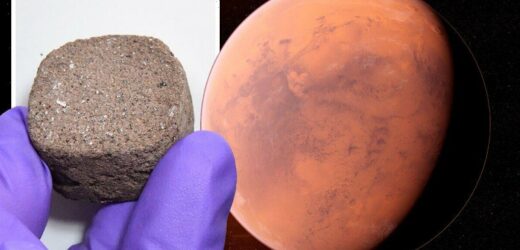European Space Agency: Solar eruption seen by Solar Orbiter
We use your sign-up to provide content in ways you’ve consented to and to improve our understanding of you. This may include adverts from us and 3rd parties based on our understanding. You can unsubscribe at any time. More info
These blocks, which mix the urine of astronauts with Martian soil, could end up being the crucial foundation of civilisation on the Red Planet. They are formed by mixing dust with urea, which is the primary component of urine, along with bacteria as well guar gum and nickel chloride. The resulting mixture looks like a slurry, which the astronauts then poured into moulds of any shape.
Over the course of a few days, the bacteria in the mixture convert urea into calcium carbonate crystals.
With the help of some biopolymers that are secreted by the bacteria, these crystals act as cement that holds the soil particles together.
Developed by researchers from the Indian Institute of Science, these space bricks are less porous than others which researchers have tried to use to make Martian bricks.
One reason for this is that the bacteria tend to seep deep inside the bricks’ pore spaces and use their proteins to bind particles together, making them stronger.


Published in the journal PLoS One, these researchers found that this new way of making bricks on mars can be incredibly versatile, making complex shapes.
Previous methods involved trying to make bricks from soil obtained from the moon, which could only produce cylindrical-shaped bricks.
Initially, the researchers found that the bacteria did not grow at all due to the high iron quantity in martian soil, which can be toxic for many organisms.
Nickel chloride was the key ingredient that unlocked the process and made the soil hospitable for bacteria.

The researchers are now looking to understand how the atmosphere and low gravity on Mars would affect the strength of the space bricks.
The Martian atmosphere, which is 100 times thinner than that of Earth, is made up of 95 percent carbon dioxide, which could significantly stunt bacterial growth.
In order to study the impacts of the martian atmosphere, the researchers have created a Martian Atmosphere Simulator device that reproduces the atmospheric conditions of the red planet in a lab.
The scientists have also developed a lab-on-a-chip device that will measure bacterial activity in microgravity conditions.
DON’T MISS:
Germany strikes huge energy deal with India to slash Russia reliance [REVEAL]
VDL faces nightmare as EU rebels refuse to back sanctions [INSIGHT]
Russia’s ‘only oil pipeline to EU’ in flames – 3 countries face crisis [SPOTLIGHT]


With help from the Indian Space Research Organisation, the team plan to send such devices into space, so that they can study the effect of low gravity on bacterial growth.
Dr Aloke Kumar, a senior author of the study said: “I’m so excited that many researchers across the world are thinking about colonising other planets.
“It may not happen quickly, but people are actively working on it.
“This biological approach, coupled with a scalable casting method, towards manufacturing of bricks presents a promising and highly sustainable potential route for in situ utilization of structural elements on extra-terrestrial habitats.”
Source: Read Full Article


